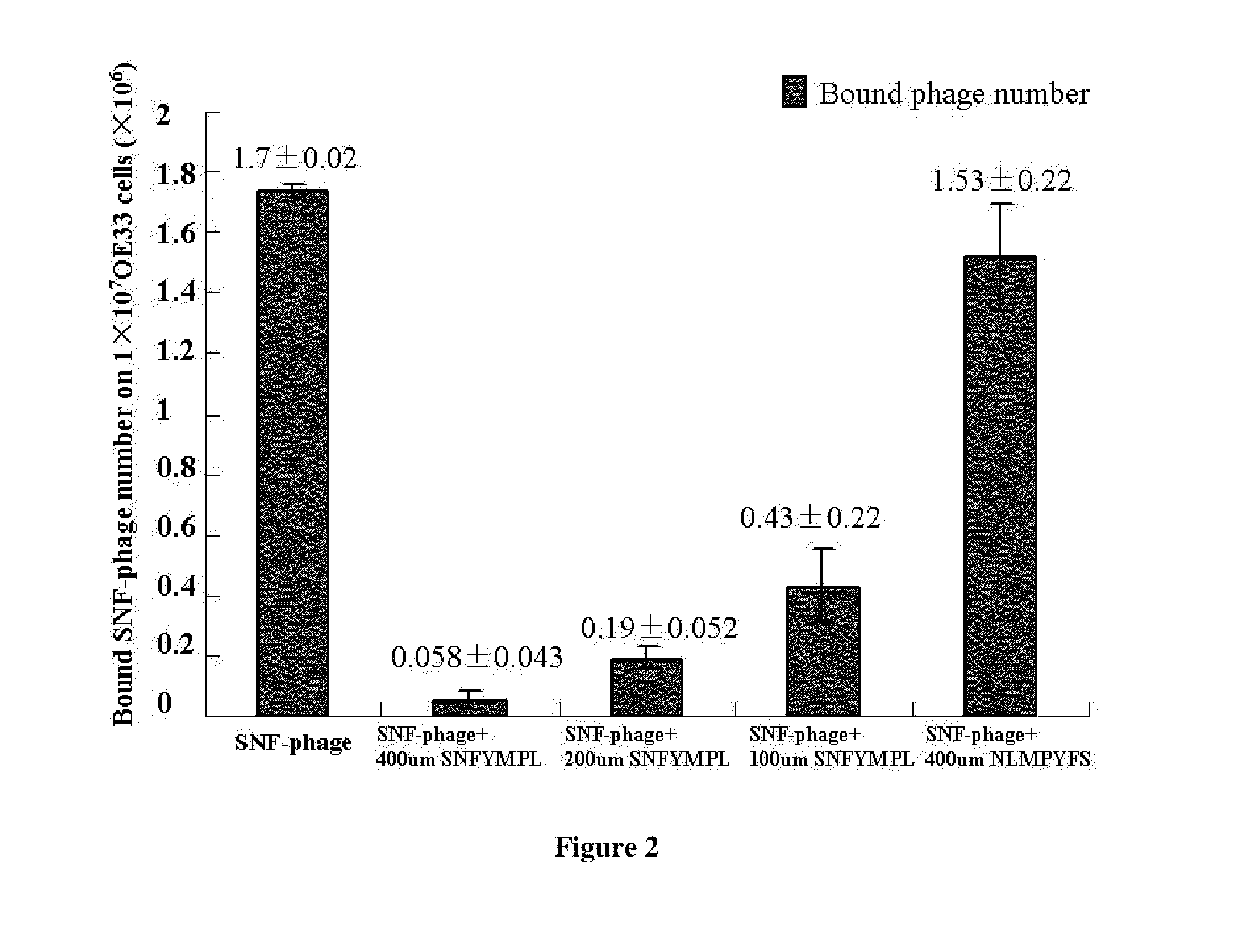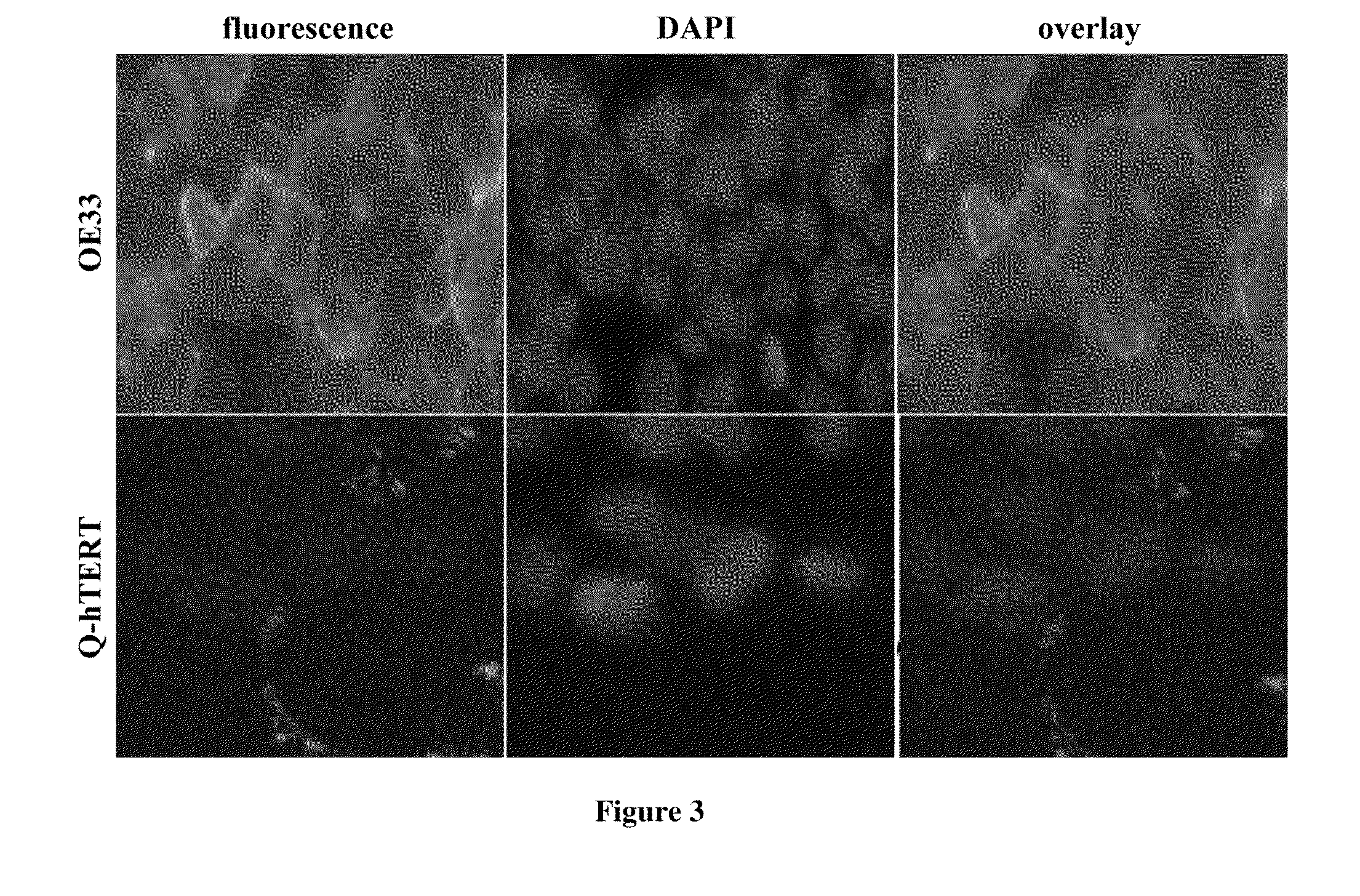Targeted Detection of Dysplasia In Barrett's Esophagus With A Novel Fluorescence-Labeled Polypeptide
a polypeptide and dysplasia technology, applied in the field of use in detecting dysplasia in barrett's esophagus, can solve the problems of ineffective detection of flat dysplasia, low detection yield, and significant limitations of approach, and achieve the effect of increasing the detectable binding of the polypeptide sequen
- Summary
- Abstract
- Description
- Claims
- Application Information
AI Technical Summary
Benefits of technology
Problems solved by technology
Method used
Image
Examples
example 1
[0057]Pepide Selection. Peptide selection was performed using techniques of phage display (Ph.D.-7, New England Biolabs, Beverly, Mass.). The esophageal adenocarcinoma cell line OE33 was maintained in RPMI-1640 media supplemented with 10% FBS. The Barrett's esophagus (intestinal metaplasia) cell lines KR-42421 (Q-hTERT, non-dysplastic) was maintained in keratinocyte-serum free medium supplemented with bovine pituitary extract (BPE) and human recombinant epidermal growth factor (rEGF) (Invitrogen, Carlsbad, Calif.). All cell lines were incubated at 37° C. in 5% CO2.
[0058]Biopanning was carried out by using a subtractive whole-cell approach. Q-hTERT cells in log-phase growth were detached with cell dissociation buffer (Invitrogen, Carlsbad, Calif.) and blocked with blocking buffer (PBS with 1% bovine serum albumin) for 45 minutes on ice. Ten μl of Ph.D.-7 random phage library (1.5×10″ plaque-forming unit) was suspended in 5 ml PBS and biopanned with 1.0×107 Q-hTERT cells for 30 min at...
example 2
[0062]Phage Binding Assay. OE33 and Q-hTERT cells were detached and blocked as described above. The candidate SNFYMPL-phage or control phage (randomly insert) were incubated with OE33 cells (1×107) or Q-hTERT cells (1×107) for 30 min with gentle agitation at room temperature. After washing ten times with PBS / 0.1% (v / v) Tween-20 and one time with 0.2 M glycine, pH 2.2 / 0.1% BSA for two minutes, the bound phages were recovered and titered. Every sample was carried out in triplicate. The amount of bound phages in every sample was calculated using student's t test.
[0063]Cell ELISA for Phage Binding Assay. OE33 cells and Q-hTERT cells were grown to 100% confluence in a 96-well plate and incubated sequentially with 2×107 pfu SNFYMPL-phage or control phage for 10 minutes in triplicate at room temperature, washed with PBS containing 0.1% Tween-20 six times, incubated with HRP-labeled anti-M13 antibody (Fitzgerald, Concord, Mass.), developed with TMB (Invitrogen, Carlsbad, Calif.), and absorb...
example 3
[0069]Fluoresence images for peptide binding on culture cells. The OE33 and QhTERT cells were grown in chamber slides to 80% confluence. Blocking of non-specific binding to these cells was performed by adding 200 μl of 1% BSA diluted in PBS for 30 min. The cells were then incubated with 100 μmol of the candidate FITC-labeled peptide in serum free media for 10 minutes at room temperature. The cells were washed 3 times using 200 μL PBS / 0.5% TWEEN 20 in room temperature. The cells were fixed in ice cold 4% praformaldehyde for 5 minutes. The cells were then stained with Vectashield mounting medium containing DAPI. Fluorescence images were collected with a confocal microscope (Nikon 1000) at 200×. The fluorescence intensity from the cells in 3 images was averaged to assess for peptide binding using NIH Image J software.
[0070]Under the fluoresence microscope, SNFYMPL-GGGSK-FITC was bound to the plasma membrane of >90% OE33 cells but not on Q-hTERT (normal Barrett's) cells (FIG. 3). The in...
PUM
| Property | Measurement | Unit |
|---|---|---|
| pH | aaaaa | aaaaa |
| pH | aaaaa | aaaaa |
| pH | aaaaa | aaaaa |
Abstract
Description
Claims
Application Information
 Login to View More
Login to View More - R&D
- Intellectual Property
- Life Sciences
- Materials
- Tech Scout
- Unparalleled Data Quality
- Higher Quality Content
- 60% Fewer Hallucinations
Browse by: Latest US Patents, China's latest patents, Technical Efficacy Thesaurus, Application Domain, Technology Topic, Popular Technical Reports.
© 2025 PatSnap. All rights reserved.Legal|Privacy policy|Modern Slavery Act Transparency Statement|Sitemap|About US| Contact US: help@patsnap.com



